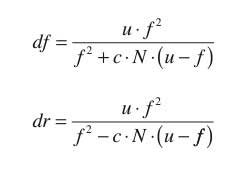Ralph, if I can answer this otherwise two-sided argument, I would like to refer to the very well explained text of Cambridge in Colour to which I have often referred.
It says, among other:
When does the circle of confusion become perceptible to our eyes? An acceptably sharp circle of confusion is loosely defined as one which would go unnoticed when enlarged to a standard 8x10 inch print, and observed from a standard viewing distance of about 1 foot.
At this viewing distance and print size, camera manufactures assume a circle of confusion is negligible if no larger than 0.01 inches (when enlarged). As a result, camera manufacturers use the 0.01 inch standard when providing lens depth of field markers (shown below for f/22 on a 50mm lens). In reality, a person with 20-20 vision or better can distinguish features 1/3 this size or smaller, and so the circle of confusion has to be even smaller than this to achieve acceptable sharpness throughout.
A different maximum circle of confusion also applies for each print size and viewing distance combination.
(bold mine).
You say, if I get you right, that the DoF is "locked" into the negative, as the enlargement is supposed to be made in a way that the larger the enlargement, the larger the viewing distance, so that enlarging is out of the equation and in fact in the equation you give "enlarging" does not seem to take part.
But in the course of this discussion, the point that raised the divergence between you and Q.G. was, on post #76, that by enlarging "more" a portion of a certain negative one ends up with the same DoF that he would have had by shooting that portion of negative "straight away" (shooting with a smaller format). Your point being that smaller formats have more DoF and the point by Q.G. and by me being that the more you enlarge the smaller negative the less you have DoF so DoF is depending on enlargement.
In this context, what Q.G and I are saying is that you enlarge your negative more than the standard reference points which people take as "given" and keep as constant when they write those equations that you quote.
In the text that I quoted above, reference is made to the enlargement as it is, in fact, one of the things to be taken into account when we consider comparisons among formats.
Reading again the thread, I would also like to express my point again regarding your affirmation in post #72, and then by hpulley in post #73, to which both I peacefully disagree.
The point some of us were raising in this thread it is that micro formats are NOT kissed by a larger DoF even if it seems so given to our habit to compare different magnifications (equal final prints of different sized negatives).
If you compare equal magnifications of the negatives, micro formats don't have any more DoF than "macro" formats.
To explain this strange proposition, consider this:
you go round with two cameras: one is a 135film camera, and the other is a film camera that has the film surface of the 4:3 standard :wizard:
You take the same scene with a 25mm on both cameras. The area covered by the full frame of the 135 will be "wide-angle". The area covered by the 4:3 film camera will be "normal". So the two scenes will differ in your viewfinders.
When at home, if you print only the portion of the 135 corresponding to the 4:3, you will have the same image, same perspective, and importantly same DoF that you obtain when you print the entire 4:3 frame.
That would be "equal magnification", because you enlarge your negative the same "number of times" in both prints.
If, instead, you print the two images "full frame", you will have a different magnification, because you will have enlarged the 135 less than the 4:3.
In this second case, the print you make of the 135 full frame is enlarged "less" than the other, hence the higher apparent DoF. "Apparent" you will object. I see that DoF clearly being there. Yes. It's there, because the negative is less enlarged and the CoC less apparent. So it's there, but it is a result of the lesser magnification of the negative.
I don't know if I made my point clear. I hope we can discuss this very interesting technical topic without it becoming a competition about who's got it longer

Fabrizio









 )
)





